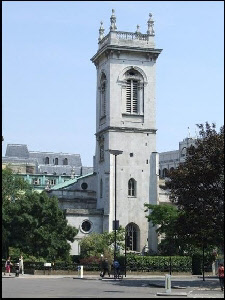On 7 Sept 1940, the Germans started a policy of strategic bombing of non-military targets – first used by the Germans on a small though devastating scale in the Spanish Civil War – and London was the centre of that attack. The campaign lasted 57 consecutive days – all the way until 10 May 1941. We have already seen that this was the night when St Mary le Bow was destroyed by all the nearby burning buildings, but the Holborn area was heavily affected and well into the 1980s there were bomb sites around us. Strategic bombing caused the loss of 40,000 civilian lives in England, of whom 23,000 lived in London.
I put the photo of Christ Church Greyfriars at the head of the page because I have family who were christened and married there, and it is such a sad and poignant reminder of what London lost in those terrible days
The Wren tower has been restored, but the walls on this side of the building were demolished for a road widening scheme. The Pineapple Project hopes to restore the missing walls, but there are no plans to replace the building.
On 7 May 1941, the church of St Andrew Holborn, pictured left and sited on Holborn Circus, was completely gutted by bombing and eventually it was decided to restore the building “brick for brick and stone for stone” to the original Wren design for the largest parish church he built. During its restoration, the old crypt was discovered and hinted at religious observance on this site since the Romans arrived, 2000 years ago.
If you look at the new building going up opposite, called 40 Holborn Viaduct, it was the subject of a very famous Blitz photo; a fire engine is parked next to Prince Albert’s statue and its crew is fighting the blaze.
There is much to be known about the effect of the Blitz on Holborn, for which there is plenty of room below, and I’ll continue this story later. In the meantime, look for St Albans Church near the red-brick Prudential building and St Ethelreda’s in Ely Place. St Albans was substantially destroyed and rebuilt and St Ethelreda’s lost its nave. The spirit of London is such that these fine buildings are standing proud again today, in continuous use.
In the end the tactic of strategic bombing was counter-productive. The bombs did not destroy English morale; they may have strengthened it. The time and effort that should have been spent destroying the RAF was dissipated into a huge cushion that could absorb as much military ordinance as the enemy could discharge. The German distraction from the war effort to the bombing of London (and other cities) allowed the British to perfect their radar, re-build their air bases and their air force, and probably prevented the planned invasion of England. Military strategists might like to take note.



